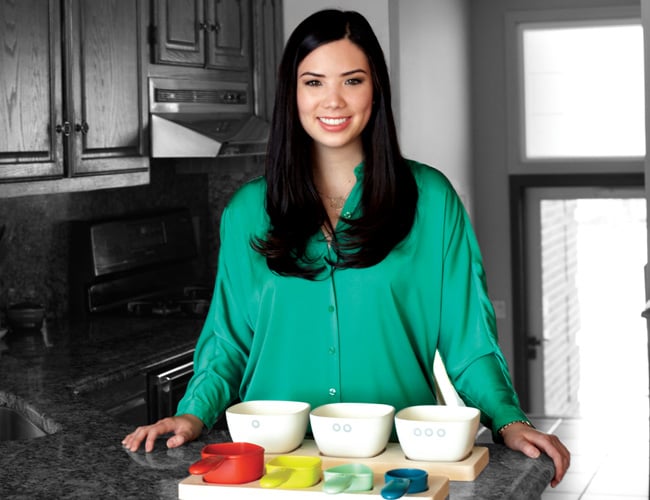
June 6, 2013
Designing for Autism: Enabling Independence with Good Design
A young designer creates an ingenious set of cooking tools (with accompanying app) that enables her autistic brother to cook for himself.

Portrait by Winnie Au
Twenty-three-year-old Amanda Savitzky is the 2013 winner of the Next Generation Design Competition.
For most of us, preparing instant pancakes from a box is an easy, three-step affair. Gather and mix a few ingredients, pour the batter into a hot pan, flip. For Steven Savitzky, however, the process isn’t so simple. He was diagnosed with autism spectrum disorder (ASD) at 18 months and today, at age 20, still lives at home with his parents on Long Island, New York. For him, the kitchen is a distressing place. “It’s a sensory-rich environment, and that can be a barrier for someone with autism,” says Steven’s 23-year-old sister, Amanda Savitzky.
Cooking is a messy, chaotic affair, requiring both gross and fine motor skills and a level of attention and cognition that can elude many with this disorder. But on a rainy day in early April, Amanda and her parents, Lily and Bob, gathered in the family’s open kitchen to watch as Steven made one of his favorite foods—pancakes—by himself.
Steven navigated the kitchen using a colorful set of tools called Match Cooking Prep System for People with Autism Spectrum Disorder. Amanda developed the system in 2012 for her thesis project in industrial design at Syracuse University, and her pragmatic and thoroughly researched design won the $10,000 top prize in the 2013 Metropolis Next Generation Competition.
This year’s competition honed in on an often overlooked but pervasive design necessity in our culture: solutions that help those with a special need live an independent life. The guidelines specifically asked young designers to consider someone in his or her own life who could benefit from inclusive design.
The Match Cooking Prep System encourages adults with autism to gather, measure, and mix food in the kitchen using an integrated set of tools. Four measuring cups composed of easy-to-grip ergonomic handles come in four different shapes and colors that are equivalent to basic culinary measurements: a red pentagon equals one cup, a yellow square equals half a cup, a green triangle equals a third of a cup, and a blue circle equals a quarter cup. The cups line a thick wooden board where the corresponding shapes are cut into the base and each cup locks into place with a magnet— creating a satisfying click for the user. The device is reminiscent of a board puzzle for toddlers. Another wood board houses three prep bowls of varying sizes that can be used for mixing ingredients.
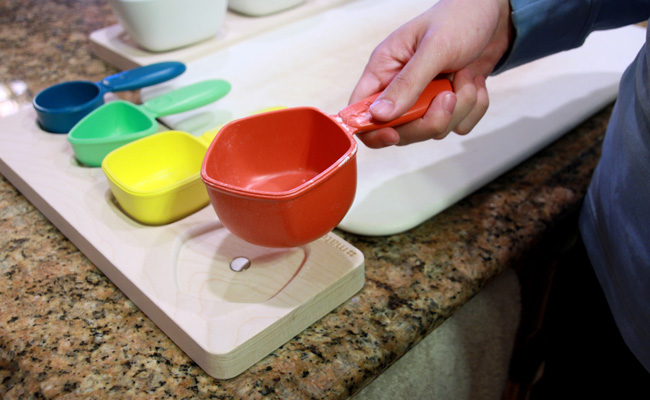
Courtesy Amanda Savitzky
The cups snap into place with magnets, like puzzle pieces.
The final component in the system is a Match iPad app, a platform for caregivers to translate common recipes into an interactive slide show for the person with ASD. The app breaks a recipe into a simple set of tasks that the user can scroll through and applies the colors and shapes of the Match measuring cups in place of the numeric measurements. It also allows the caregiver or teacher to upload pictures in order to customize the recipe. Many with autism have difficulty with generalization—for instance, they might not know how to get milk without seeing an actual picture of the milk carton in their refrigerator— so by uploading pictures specific to the user’s environment, the Match iPad app recipe prompts the user to walk through his or her own kitchen, step by step.
Amanda’s interest in designing for young adults with autism was sparked when she left for college in 2007, and thought about her brother still at home. “Most people go through typical rites of passage—college, developing friends, finding jobs, getting married—and this is not a natural trajectory for people with autism,” she says. Amanda focused on the kitchen because she wanted to offer her brother a sense of independence and accomplishment. “Cooking is important to our family,” Amanda says. “My mom, my older sister, and I cook together, but Steven could never participate in that. What’s more important than feeding yourself?”
While the Match Cooking Prep System may have been personal for Amanda, the problem she addressed is pervasive. The Centers for Disease Control and Prevention report that an alarming one in 88 children (one in 54 boys) is diagnosed with ASD, a disorder that affects all ethnic and socioeconomic populations equally. Most research funding and awareness campaigns center on early diagnosis and childhood treatment, and on finding ASD’s root cause. But thousands of young adults with autism, like Steven, are aging out of well-funded support networks such as public education systems, and entering adulthood with little to no support.
“This is the new frontier for design,” says Patricia Moore, an industrial designer and gerontologist who served as one of this year’s Next Gen judges. Moore is a longtime advocate for accessible design—she helped write the Americans with Disabilities Act— and in 1979, at the age of 26, she transformed herself into an 85-year-old to experience what it was like navigating the built environment as an elder. In spite of her vast experience with inclusive design, Amanda’s project surprised Moore. “It was really an ‘aha’ moment for me,” she says about realizing the sheer number of adults and caregivers affected by autism. “We spend much of our creative effort in building capacity with little ones and then it’s almost as if we abandon them once they age out.” A child with autism becomes an adult with autism, which can greatly tax caregivers who are also aging.
More than simply designing new kitchen equipment, Amanda aimed to develop a culinary infrastructure that would make the kitchen a safe environment and would emphasize independence for both the person with autism and the caregiver: “I was trying to build a system where the user can’t fail.”
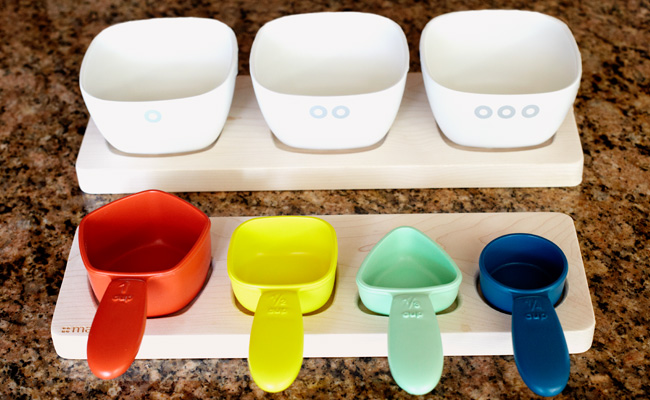
Courtesy Amanda Savitzky
The measuring cups combine visual shapes and colors to coordinate with basic measurements.
At Syracuse, Amanda double majored in psychology and industrial design because she believed that any successful product needed to be rooted in a well-researched comprehension of autism. Natalie Russo, an assistant professor of psychology at Syracuse, helped Amanda understand how people on the spectrum process and integrate sensory information in the brain. “When developing individuals get pieces of information from two senses, like sight and sound, that person gets a boost of brain processing that helps connect the dots,” Russo says. “That doesn’t happen with autism.”
Russo’s research attempts to understand how the autistic brain processes sensory information, and she takes a “strength-based perspective” in this work. “Kids with autism can often detect differences better than we can; for instance, they might excel at Where’s Waldo?” she says. “We know their brains function differently, so how can we make the world more accommodating? I tend to like square pegs; I don’t want to fit them in round holes, and Amanda’s project fits nicely with that idea. She’s not saying that we need to teach kids with autism the way everyone else is taught; she’s asking how we can change what we provide to support the way that they are.”
Amanda had already learned a great deal about strength-based education for autism by watching her parents rear Steven. Lily and Bob helped pioneer the inclusion of autistic children in their local public school system, and they advocated for the use of applied behavioral analysis (ABA) with their son. ABA uses evidence-based, pragmatic lessons to teach a skill and reward success by breaking down activities, such as showering or getting dressed, into an orderly chain of steps known as a task analysis (think back to the recipe on that box of pancake mix). This task analysis can be turned into something known as a picture schedule, which is an illustrated version of the instructions. The caregiver then uses special prompts to help the autistic child learn each step of the task. There are different types of prompts: simple verbal instructions; modeling how something is done; or a hands-on touch that physically directs the person.
With the Match Cooking Prep System, Amanda built the task analysis and the prompts into a system for making food. First, she analyzed the steps necessary to gather and prep a simple meal—from washing hands and gathering ingredients to measuring and mixing—and then she considered the hurdles that might derail an autistic person in those steps. “I watched my brother trying to use a small measuring cup. He was holding it with a pincer grip and was shaking because he didn’t have the fine motor skill to grip that handle.” Those measuring cups were stackable to save space, but the stacking confused him, and the measurement designations meant nothing. “What does one over four mean to someone who doesn’t get it?”she asks. One of the first skills taught to an autistic child is matching colors and shapes. “I thought, why not make the measuring cups different shapes? So a quarter cup becomes a blue circle and a half cup becomes a yellow square.”
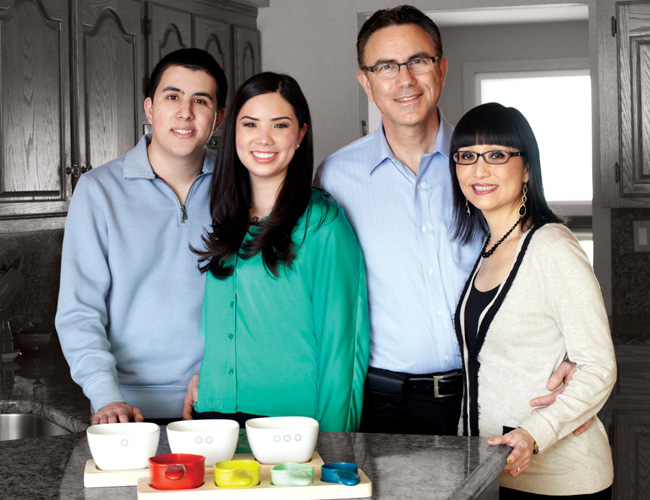
Portrait by Winnie Au
Steven, Amanda, Bob, and Lily Savitzky in their Plainview, New York kitchen.
Amanda spent hours walking through home stores researching kitchen equipment, and that’s how she hit on the idea of mise en place. “That’s a French culinary tradition used by some of the world’s best chefs to organize all of the ingredients first and then cook,” she says. “I knew that this technique would be awesome for someone with autism.”
People with autism thrive on consistency and routine, and research has shown that a visually organized workstation with spatial sequencing—where everything moves from left to right—helps. This informed the linear placement of the Match measuring cups and bowls on the wooden boards. “They can predict how things work, and when they get a new task they feel confident because they understand the basic structure,” Amanda says.
Throughout her design process, Amanda consulted with Brad Richards, an autism expert who runs a group home for adults with ASD near the Savitzkys’ house on Long Island. Richards coordinates cooking classes for the adults in his home and he says the Match Cooking Prep System succeeds in decreasing reliance on the caregiver and increasing independence for the individual. The system has other implications as well. “A frequent side effect of ASD is a picky palate, and nutritional deficiencies can become an issue,” Richards says. By developing the skills necessary to feed oneself, rather than constantly being served food, a person “becomes more interested in the food and increases the types of food that they will eat.”
The Match Cooking Prep System sparked a robust discussion among the four judges of this year’s Next Gen competition. At first, the seeming simplicity of Amanda’s design raised questions among them, but once the totality of her idea was understood in context, it became the clear frontrunner. “Amanda did what every good designer should do: step back and question some fundamental assumptions,” says Gianfranco Zaccai, president and chief design officer of Continuum and a judge in the competition. Zaccai stressed the importance of a product capable of coming to market quickly. “There have been lots of utopian ideas about how to create an ideal environment for a person with a disability, but people have to be able to live in a variety of environments and they have to be able to afford it, so coming up with a simple set of tools is a lot more meaningful.”
Keeping it simple and affordable was key to Amanda’s design. “Caregivers can’t afford expensive solutions,” Amanda says. “I knew I wanted a practical set of tools that could be created now. My professors challenged me and I would always chal- lenge them back. It couldn’t be the ‘kitchen-of-the-future’ with a $10,000 Microsoft Surface tablet. It had to be affordable, small, and practical.”
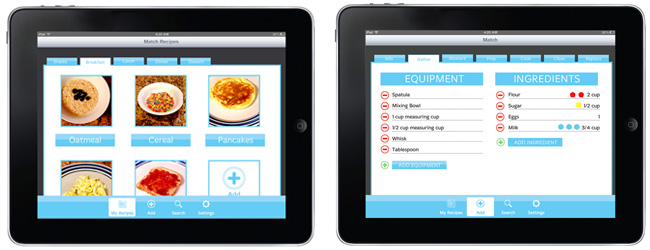
Courtesy Amanda Savitzky
When designing the iPad app for Match, Savitzky reminded herself that the software had to work for different people. “I was mindful that the system had two user groups: the person with autism and the caregiver.”
Amanda plans to use her Next Gen winnings to further develop the prototype and help bring the product to market. Marsha Maytum, partner in the San Francisco–based firm Leddy Maytum Stacy Architects, hopes that happens. Maytum’s firm designed Sweetwater Spectrum in downtown Sonoma, California, which became the nation’s first community built specifically for autistic adults when it opened this year. “This would be an incredibly useful product and I can see this being put to good use at Sweetwater,” Maytum says. “It’s notable that Amanda is handling the tactile, in-the-moment world, but also creating technology that allows it to be customized in ways that are most successful to individual users.”
The judges note that the Match Cooking Prep System has implications well beyond autism, including supporting aging Baby Boomers with increased cases of dementia. “This would be helpful for anyone with traumatic brain injury, dementia, or someone who just had a stroke,” Moore says.
Back in the Savitzkys’ kitchen on Long Island, Steven’s family, along with Brad Richards, cheer him on as he successfully measures pancake mix and then water into the appropriate cups and pours each into the Match prep bowls. Lily sits in a chair nearby and pretends to tie her hands behind her back. “I cannot help him, he’s going to do this all by himself!” she says. Lily has spent hours in the kitchen with Steven practicing the pancake prep with the prototype system, and her two decades of hands-on caregiving make it hard to now sit back and watch. “I’m a mom,” Lily says. “I’m so eager to jump in and help him. I don’t want him to fail.”
Steven is meticulous and focused, completing each step and knowing to scroll to the next instruction on the iPad. Everyone claps and gives encouragement with each success, but as he reaches for an egg the room falls silent. Steven hesitates momentarily then cracks the egg expertly into a bowl. He looks up and says: “How am I doing?” Everyone bursts into applause. Lily has tears in her eyes: “You’re doing great. I’m so proud of you.”





